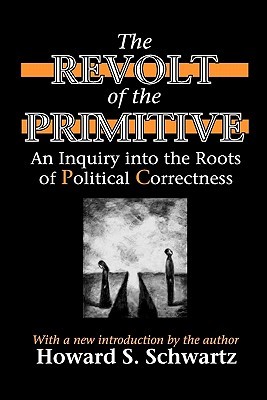A woman files a sexual-harassment suit against a man for wearing spandex shorts. A black college student tacks racist notes on his own door to try to start a campus outcry against racism. Howard Schwartz has tried to explain these and other examples of political correctness in psychological terms in The Revolt of the Primitive. For his purposes, Schwartz establishes a hypothetical American family to illustrate the findings he has taken from his source material.
He presents an elaborate model of psychological roles within this imaginary suburban family that, unfortunately, is so exaggerated that it is difficult to imagine that it represents anything in reality. Schwartz’s family consists of the “toxic man,” the “primordial mother,” a son, and a daughter who is a spoiled, power-hungry monster. The mother is the only parent to whom the children seem to relate in any natural way. They use her to gain power over their disconnected father, who is away from home between 8:00 A.M. and 5:00 P.M. daily in order to provide for the family. Schwartz predicts that the son will grow up to be a replica of his cold, distant father. The family’s only hope lies with the spoiled daughter, and we might assume that she will follow in her mother’s footsteps. In fact, Schwartz suggests that the life of the suburban housewife is the girl’s worst nightmare—from which the university ultimately rescues her.
Schwartz’s depiction of the daughter rings true. Without knowing what feminism really means, many young women, Schwartz suggests, subscribe to the view that men are evil, marriage is a trap, and anyone (nearly always a man) who thwarts their desires is in the wrong. Just as the mother has more presence (and, therefore, more power) in the family than the absent father, the daughter is sure to have a controlling impact on the men she will meet and relate to. So she heads for college, where she is taught that she is a victim of an oppressive, patriarchal society. Also, she learns the main premise of a modern college education: that men—especially white ones—are responsible for all of society’s ills. Her white male peers, in their 20 or so years of life, have somehow perpetrated slavery, the holocaust, and the putative crime of the masculine sex drive.
The military, traditionally a haven for men, suffers from the same disease as the university, Schwartz argues. His chapter on the Armed Forces is a collection of stories and quotations from other people’s books and articles pertaining to sexual-harassment charges, plus an extensive treatment of the “cultural problem” of Tailhook and the incidents of abuse that marred its 1991 convention.
Tailhook, a meeting of carrier pilots sanctioned by the U.S. Navy, had a reputation for wildness and debauchery that reached an exultant pinnacle following the Gulf War. Tailhook had been around since 1956; though the convention had been barred from several cities, it had never drawn a charge of sexual assault before Lt. Paula Coughlin alleged one. Coughlin had willingly engaged in sexual activities at Tailhook, which she later chose to define as assault. Schwartz comments:
[W]hat is interesting . . . is the way the acts in which women participated enthusiastically were responded to with the same outrage as the acts of patent abuse, as if the two were equivalent . . .
The illogical conclusion many people drew from the Tailhook incident was that, since overt sexism exists in the military, throwing women into combat is a good thing. Schwartz puts the case well when he writes,
>
The women who want women to be in combat do not understand what combat means, nor do they value it—they don’t want men to have something by which they can define their identity as men.
The politically correct definition of sexism, Schwartz explains, is exclusion. The important thing is not that women are less suited for a certain task than men but merely that someone has drawn attention to the fact.
Schwartz ends his book with a chapter on the irrationality of the left’s perception of white males, taking the example of the Columbine massacre for a peg. While the perpetrators were indeed white males, that fact was not quite enough to hang their crimes on; contributing also were violent video games—as well as guns. Schwartz’s reverse-psychological interpretation of the events is sufficiently interesting: He assesses the brief moments of pain the gunshot wounds inflicted on Harris’s and Klebold’s victims, compared to the years of pain and suffering the two gun-men endured at the hands of their classmates.
In summation, Schwartz writes,
[T]he problems that the revolt of the primitive has brought—a generation of confused and helpless male children, of women intoxicated by self-worship and victimized by their own grandiosity, decomposition of the family, destruction of the educational system, castration of the military, and many that we have not even mentioned—are monumental. Yet the worst of these is the undermining of self-criticism.
That is a true and poignant statement identifying the source of postmodernism and the breakdown of our culture. Sophocles, however, has the last word: “Think no longer / That you are in command here, but rather think / How, when you were, you served your own destruction.”
[The Revolt of the Primitive: An Inquiry Into the Roots of Political Correctness, by Howard S. Schwartz (Westport, CT: Praeger Publishers) 214 pp., $67.95]

Leave a Reply